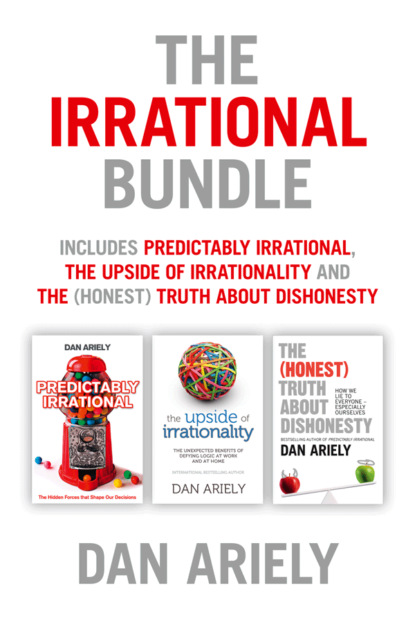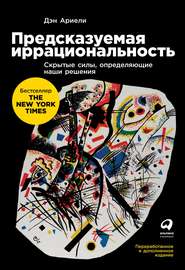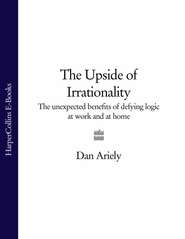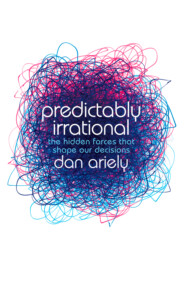По всем вопросам обращайтесь на: info@litportal.ru
(©) 2003-2024.
✖
The Irrational Bundle
Автор
Год написания книги
2018
Настройки чтения
Размер шрифта
Высота строк
Поля
As it turned out, the participants were not motivated to work at all when they got the 50-cent Snickers bar, and in fact the effort they invested was the same as when they got a payment of 50 cents. They reacted to the explicitly priced gift in exactly the way they reacted to cash, and the gift no longer invoked social norms—by the mention of its cost, the gift had passed into the realm of market norms.
By the way, we replicated the setup later when we asked passersby whether they would help us unload a sofa from a truck. We found the same results. People are willing to work free, and they are willing to work for a reasonable wage; but offer them just a small payment and they will walk away. Gifts are also effective for sofas, and offering people a gift, even a small one, is sufficient to get them to help; but mention what the gift cost you, and you will see the back of them faster than you can say market norms.
THESE RESULTS SHOW that for market norms to emerge, it is sufficient to mention money (even when no money changes hands). But, of course, market norms are not just about effort—they relate to a broad range of behaviors, including self-reliance, helping, and individualism. Would simply getting people to think about money influence them to behave differently in these respects? This premise was explored in a set of fantastic experiments by Kathleen Vohs (a professor at the University of Minnesota), Nicole Mead (a graduate student at Florida State University), and Miranda Goode (a graduate student at the University of British Columbia).
They asked the participants in their experiments to complete a “scrambled-sentence task,” that is, to rearrange sets of words to form sentences. For the participants in one group, the task was based on neutral sentences (for example, “It’s cold outside”); for the other group, the task was based on sentences or phrases related to money (for example, “High-paying salary”* (#litres_trial_promo)). Would thinking about money in this manner be sufficient to change the way participants behave?
In one of the experiments, the participants finished the unscrambling task and were then given a difficult puzzle, in which they had to arrange 12 disks into a square. As the experimenter left the room, he told them that they could come to him if they needed any help. Who do you think asked for help sooner—those who had worked on the “salary” sentences, with their implicit suggestion of money; or those who had worked on the “neutral” sentences, about the weather and other such topics? As it turned out, the students who had first worked on the “salary” task struggled with the puzzle for about five and a half minutes before asking for help, whereas those who had first worked on the neutral task asked for help after about three minutes. Thinking about money, then, made the participants in the “salary” group more self-reliant and less willing to ask for help.
But these participants were also less willing to help others. In fact, after thinking about money these participants were less willing to help an experimenter enter data, less likely to assist another participant who seemed confused, and less likely to help a “stranger” (an experimenter in disguise) who “accidentally” spilled a box of pencils.
Overall, the participants in the “salary” group showed many of the characteristics of the market: they were more selfish and self-reliant; they wanted to spend more time alone; they were more likely to select tasks that required individual input rather than teamwork; and when they were deciding where they wanted to sit, they chose seats farther away from whomever they were told to work with. Indeed, just thinking about money makes us behave as most economists believe we behave—and less like the social animals we are in our daily lives.
This leads me to a final thought: when you’re in a restaurant with a date, for heaven’s sake don’t mention the price of the selections. Yes, they’re printed clearly on the menu. Yes, this might be an opportunity to impress your date with the caliber of the restaurant. But if you rub it in, you’ll be likely to shift your relationship from the social to the market norm. Yes, your date may fail to recognize how much this meal is setting you back. Yes, your mother-in-law may assume that the bottle of wine you’ve presented is a $10 blend, when it’s a $60 special reserve merlot. That’s the price you have to pay, though, to keep your relationships in the social domain and away from market norms.
SO WE LIVE in two worlds: one characterized by social exchanges and the other characterized by market exchanges. And we apply different norms to these two kinds of relationships. Moreover, introducing market norms into social exchanges, as we have seen, violates the social norms and hurts the relationships. Once this type of mistake has been committed, recovering a social relationship is difficult. Once you’ve offered to pay for the delightful Thanksgiving dinner, your mother-in-law will remember the incident for years to come. And if you’ve ever offered a potential romantic partner the chance to cut to the chase, split the cost of the courting process, and simply go to bed, the odds are that you will have wrecked the romance forever.
My good friends Uri Gneezy (a professor at the University of California at San Diego) and Aldo Rustichini (a professor at the University of Minnesota) provided a very clever test of the long-term effects of a switch from social to market norms.
A few years ago, they studied a day care center in Israel to determine whether imposing a fine on parents who arrived late to pick up their children was a useful deterrent. Uri and Aldo concluded that the fine didn’t work well, and in fact it had long-term negative effects. Why? Before the fine was introduced, the teachers and parents had a social contract, with social norms about being late. Thus, if parents were late—as they occasionally were—they felt guilty about it—and their guilt compelled them to be more prompt in picking up their kids in the future. (In Israel, guilt seems to be an effective way to get compliance.) But once the fine was imposed, the day care center had inadvertently replaced the social norms with market norms. Now that the parents were paying for their tardiness, they interpreted the situation in terms of market norms. In other words, since they were being fined, they could decide for themselves whether to be late or not, and they frequently chose to be late. Needless to say, this was not what the day care center intended.
BUT THE REAL story only started here. The most interesting part occurred a few weeks later, when the day care center removed the fine. Now the center was back to the social norm. Would the parents also return to the social norm? Would their guilt return as well? Not at all. Once the fine was removed, the behavior of the parents didn’t change. They continued to pick up their kids late. In fact, when the fine was removed, there was a slight increase in the number of tardy pickups (after all, both the social norms and the fine had been removed).
This experiment illustrates an unfortunate fact: when a social norm collides with a market norm, the social norm goes away for a long time. In other words, social relationships are not easy to reestablish. Once the bloom is off the rose—once a social norm is trumped by a market norm—it will rarely return.
THE FACT THAT we live in both the social world and the market world has many implications for our personal lives. From time to time, we all need someone to help us move something, or to watch our kids for a few hours, or to take in our mail when we’re out of town. What’s the best way to motivate our friends and neighbors to help us? Would cash do it—a gift, perhaps? How much? Or nothing at all? This social dance, as I’m sure you know, isn’t easy to figure out—especially when there’s a risk of pushing a relationship into the realm of a market exchange.
Here are some answers. Asking a friend to help move a large piece of furniture or a few boxes is fine. But asking a friend to help move a lot of boxes or furniture is not—especially if the friend is working side by side with movers who are getting paid for the same task. In this case, your friend might begin to feel that he’s being used. Similarly, asking your neighbor (who happens to be a lawyer) to bring in your mail while you’re on vacation is fine. But asking him to spend the same amount of time preparing a rental contract for you—free—is not.
THE DELICATE BALANCE between social and market norms is also evident in the business world. In the last few decades companies have tried to market themselves as social companions—that is, they’d like us to think that they and we are family, or at least are friends who live on the same cul-de-sac. “Like a good neighbor, State Farm is there” is one familiar slogan. Another is Home Depot’s gentle urging: “You can do it. We can help.”
Whoever started the movement to treat customers socially had a great idea. If customers and a company are family, then the company gets several benefits. Loyalty is paramount. Minor infractions—screwing up your bill and even imposing a modest hike in your insurance rates—are accommodated. Relationships of course have ups and downs, but overall they’re a pretty good thing.
But here’s what I find strange: although companies have poured billions of dollars into marketing and advertising to create social relationships—or at least an impression of social relationships—they don’t seem to understand the nature of a social relationship, and in particular its risks.
For example, what happens when a customer’s check bounces? If the relationship is based on market norms, the bank charges a fee, and the customer shakes it off. Business is business. While the fee is annoying, it’s nonetheless acceptable. In a social relationship, however, a hefty late fee—rather than a friendly call from the manager or an automatic fee waiver—is not only a relationship-killer; it’s a stab in the back. Consumers will take personal offense. They’ll leave the bank angry and spend hours complaining to their friends about this awful bank. After all, this was a relationship framed as a social exchange. No matter how many cookies, slogans, and tokens of friendship a bank provides, one violation of the social exchange means that the consumer is back to the market exchange. It can happen that quickly.
What’s the upshot? If you’re a company, my advice is to remember that you can’t have it both ways. You can’t treat your customers like family one moment and then treat them impersonally—or, even worse, as a nuisance or a competitor—a moment later when this becomes more convenient or profitable. This is not how social relationships work. If you want a social relationship, go for it, but remember that you have to maintain it under all circumstances.
On the other hand, if you think you may have to play tough from time to time—charging extra for additional services or rapping knuckles swiftly to keep the consumers in line—you might not want to waste money in the first place on making your company the fuzzy feel-good choice. In that case, stick to a simple value proposition: state what you give and what you expect in return. Since you’re not setting up any social norms or expectations, you also can’t violate any—after all, it’s just business.
COMPANIES HAVE ALSO tried to establish social norms with their employees. It wasn’t always this way. Years ago, the workforce of America was more of an industrial, market-driven exchange. Back then it was often a nine-to-five, time-clock kind of mentality. You put in your 40 hours and you got your paycheck on Friday. Since workers were paid by the hour, they knew exactly when they were working for the man, and when they weren’t. The factory whistle blew (or the corporate equivalent took place), and the transaction was finished. This was a clear market exchange, and it worked adequately for both sides.
Today companies see an advantage in creating a social exchange. After all, in today’s market we’re the makers of intangibles. Creativity counts more than industrial machines. The partition between work and leisure has likewise blurred. The people who run the workplace want us to think about work while we’re driving home and while we’re in the shower. They’ve given us laptops, cell phones, and BlackBerries to bridge the gap between the workplace and home.
Further blurring the nine-to-five workday is the trend in many companies to move away from hourly rates to monthly pay. In this 24/7 work environment social norms have a great advantage: they tend to make employees passionate, hardworking, flexible, and concerned. In a market where employees’ loyalty to their employers is often wilting, social norms are one of the best ways to make workers loyal, as well as motivated.
Open-source software shows the potential of social norms. In the case of Linux and other collaborative projects, you can post a problem about a bug on one of the bulletin boards and see how fast someone, or often many people, will react to your request and fix the software—using their own leisure time. Could you pay for this level of service? Most likely. But if you had to hire people of the same caliber they would cost you an arm and a leg. Rather, people in these communities are happy to give their time to society at large (for which they get the same social benefits we all get from helping a friend paint a room). What can we learn from this that is applicable to the business world? There are social rewards that strongly motivate behavior—and one of the least used in corporate life is the encouragement of social rewards and reputation.
IN TREATING THEIR EMPLOYEES—much as in treating their customers—companies must understand their implied long-term commitment. If employees promise to work harder to achieve an important deadline (even canceling family obligations for it), if they are asked to get on an airplane at a moment’s notice to attend a meeting, then they must get something similar in return—something like support when they are sick, or a chance to hold on to their jobs when the market threatens to take their jobs away.
Although some companies have been successful in creating social norms with their workers, the current obsession with short-term profits, outsourcing, and draconian cost cutting threatens to undermine it all. In a social exchange, after all, people believe that if something goes awry the other party will be there for them, to protect and help them. These beliefs are not spelled out in a contract, but they are general obligations to provide care and help in times of need.
Again, companies cannot have it both ways. In particular, I am worried that the recent cuts we see in employees’ benefits—child care, pensions, flextime, exercise rooms, the cafeteria, family picnics, etc.—are likely to come at the expense of the social exchange and thus affect workers’ productivity. I am particularly worried that cuts and changes in medical benefits are likely to transform much of the employer-employee social relationship to a market relationship.
If companies want to benefit from the advantages of social norms, they need to do a better job of cultivating those norms. Medical benefits, and in particular comprehensive medical coverage, are among the best ways a company can express its side of the social exchange. But what are many companies doing? They are demanding high deductibles in their insurance plans, and at the same time are reducing the scope of benefits. Simply put, they are undermining the social contract between the company and the employees and replacing it with market norms. As companies tilt the board, and employees slide from social norms to the realm of market norms, can we blame them for jumping ship when a better offer appears? It’s really no surprise that “corporate loyalty,” in terms of the loyalty of employees to their companies, has become an oxymoron.
Organizations can also think consciously about how people react to social and market norms. Should you give an employee a gift worth $1,000 or pay him or her an extra $1,000 in cash? Which is better? If you ask the employees, the majority will most likely prefer cash over the gift. But the gift has its value, though this is sometimes ill understood—it can provide a boost to the social relationship between the employer and the employee, and by doing so provide long-term benefits to everyone. Think of it this way: who do you suppose is likely to work harder, show more loyalty, and truly love his work more—someone who is getting $1,000 in cash or someone who is getting a personal gift?
Of course, a gift is a symbolic gesture. And to be sure, no one is going to work for gifts rather than a salary. For that matter, no one is going to work for nothing. But if you look at companies like Google, which offers a wide variety of benefits for employees (including free gourmet lunches), you can see how much goodwill is created by emphasizing the social side of the company-worker relationship. It’s remarkable how much work companies (particularly start-ups) can get out of people when social norms (such as the excitement of building something together) are stronger than market norms (such as salaries stepping up with each promotion).
If corporations started thinking in terms of social norms, they would realize that these norms build loyalty and—more important—make people want to extend themselves to the degree that corporations need today: to be flexible, concerned, and willing to pitch in. That’s what a social relationship delivers.
THIS QUESTION OF social norms in the workplace is one we should be thinking about frequently. America’s productivity depends increasingly on the talent and efforts of its workers. Could it be that we are driving business from the realm of social norms into market norms? Are workers thinking in terms of money, rather than the social values of loyalty and trust? What will that do to American productivity in the long run, in terms of creativity and commitment? And what of the “social contract” between government and the citizen? Is that at risk as well?
At some level we all know the answers. We understand, for instance, that a salary alone will not motivate people to risk their lives. Police officers, firefighters, soldiers—they don’t die for their weekly pay. It’s the social norms—pride in their profession and a sense of duty—that will motivate them to give up their lives and health. A friend of mine in Miami once accompanied a U.S. customs agent on a patrol of the offshore waters. The agent carried an assault rifle and could certainly have pounded several holes into a fleeing drug boat. But had he ever done so? No way, he replied. He wasn’t about to get himself killed for the government salary he received. In fact, he confided, his group had an unspoken agreement with the drug couriers: the feds wouldn’t fire if the drug dealers didn’t fire. Perhaps that’s why we rarely (if ever) hear about gun battles on the edges of America’s “war on drugs.”
How could we change this situation? First, we could make the federal salary so good that the customs agent would be willing to risk his life for it. But how much money is that? Compensation equal to what the typical drug trafficker gets for racing a boat from the Bahamas to Miami? Alternatively, we could elevate the social norm, making the officer feel that his mission is worth more than his base pay—that we honor him (as we honor our police and firefighters) for a job which not only stabilizes the structure of society but also saves our kids from all kinds of dangers. That would take some inspirational leadership, of course, but it could be done.
Let me describe how that same thought applies to the world of education. I recently joined a federal committee on incentives and accountability in public education. This is one aspect of social and market norms that I would like to explore in the years to come. Our task is to reexamine the “No Child Left Behind” policy, and to help find ways to motivate students, teachers, administrators, and parents.
My feeling so far is that standardized testing and performance-based salaries are likely to push education from social norms to market norms. The United States already spends more money per student than any other Western society. Would it be wise to add more money? The same consideration applies to testing: we are already testing very frequently, and more testing is unlikely to improve the quality of education.
I suspect that one answer lies in the realm of social norms. As we learned in our experiments, cash will take you only so far—social norms are the forces that can make a difference in the long run. Instead of focusing the attention of the teachers, parents, and kids on test scores, salaries, and competition, it might be better to instill in all of us a sense of purpose, mission, and pride in education. To do this we certainly can’t take the path of market norms. The Beatles proclaimed some time ago that you “Can’t Buy Me Love” and this also applies to the love of learning—you can’t buy it; and if you try, you might chase it away.
So how can we improve the educational system? We should probably first rethink school curricula, and link them in more obvious ways to social goals (elimination of poverty and crime, elevation of human rights, etc.), technological goals (boosting energy conservation, space exploration, nanotechnology, etc.), and medical goals (cures for cancer, diabetes, obesity, etc.) that we care about as a society. This way the students, teachers, and parents might see the larger point in education and become more enthusiastic and motivated about it. We should also work hard on making education a goal in itself, and stop confusing the number of hours students spend in school with the quality of the education they get. Kids can get excited about many things (baseball, for example), and it is our challenge as a society to make them want to know as much about Nobel laureates as they now know about baseball players. I am not suggesting that igniting a social passion for education is simple; but if we succeed in doing so, the value could be immense.
MONEY, AS IT turns out, is very often the most expensive way to motivate people. Social norms are not only cheaper, but often more effective as well.
So what good is money? In ancient times, money made trading easier: you didn’t have to sling a goose over your back when you went to market, or decide what section of the goose was equivalent to a head of lettuce. In modern times money has even more benefits, as it allows us to specialize, borrow, and save.
But money has also taken on a life of its own. As we have seen, it can remove the best in human interactions. So do we need money? Of course we do. But could there be some aspects of our life that would be, in some ways, better without it?
That’s a radical idea, and not an easy one to imagine. But a few years ago I had a taste of it. At that time, I got a phone call from John Perry Barlow, a former lyricist for the Grateful Dead, inviting me to an event that proved to be both an important personal experience and an interesting exercise in creating a moneyless society. Barlow told me that I had to come to Burning Man with him, and that if I did, I would feel as if I had come home. Burning Man is an annual week-long event of self-expression and self-reliance held in Black Rock Desert, Nevada, regularly attended by more than 40,000 people. Burning Man started in 1986 on Baker Beach in San Francisco, when a small crowd designed, built, and eventually set fire to an eight-foot wooden statue of a man and a smaller wooden dog. Since then the size of the man being burned and the number of people who attend the festivities has grown considerably, and the event is now one of the largest art festivals, and an ongoing experiment in temporary community.
Burning Man has many extraordinary aspects, but for me one of the most remarkable is its rejection of market norms. Money is not accepted at Burning Man. Rather, the whole place works as a gift exchange economy—you give things to other people, with the understanding that they will give something back to you (or to someone else) at some point in the future. Thus, people who can cook might fix a meal. Psychologists offer free counseling sessions. Masseuses massage those lying on tables before them. Those who have water offer showers. People give away drinks, homemade jewelry, and hugs. (I made some puzzles at the hobby shop at MIT, and gave them to people. Mostly, people enjoyed trying to solve them.)
At first this was all very strange, but before long I found myself adopting the norms of Burning Man. I was surprised, in fact, to find that Burning Man was the most accepting, social, and caring place I had ever been. I’m not sure I could easily survive in Burning Man for all 52 weeks of the year. But this experience has convinced me that life with fewer market norms and more social norms would be more satisfying, creative, fulfilling, and fun.
The answer, I believe, is not to re-create society as Burning Man, but to remember that social norms can play a far greater role in society than we have been giving them credit for. If we contemplate how market norms have gradually taken over our lives in the past few decades—with their emphasis on higher salaries, more income, and more spending—we may recognize that a return to some of the old social norms might not be so bad after all. In fact, it might bring quite a bit of the old civility back to our lives.
Reflections on Social Norms: Lessons on Gifts
When we mix social and monetary norms, strange and undesirable things can happen. For example, if you walk your date home after a wonderful evening together, don’t mention how much the evening set you back. That is not a good strategy for getting a passionate good-night kiss. (I certainly do not recommend this as an experiment, but if you do try it, let me know how it turns out.) Dating, of course, is just one arena in which we can mess up a social relationship by introducing financial norms, and this danger lurks around many corners.
On some level we all know this, and therefore we sometimes deliberately make decisions that do not fall into line with rational economic theory. Think of gifts, for example. From a standard economic perspective, they are a waste of money. Imagine that you invite me to your home for dinner one evening, and I decide to spend $50 on a nice bottle of Bordeaux as a token of gratitude. There are some problems with this decision: You might not like Bordeaux. You might have preferred something else: a copy of Predictably Irrational, a DVD of Citizen Kane, or a blender. This means that the bottle of wine that cost me $50 might be worth, at most, $25 to you in terms of its utility. That is, for $25 you could get something else that would make you just as happy as my $50 bottle of wine.
Now, if giving gifts was a rational activity, I would come to dinner and say, “Thank you for inviting me for dinner. I was going to spend $50 on a bottle of Bordeaux, but I realize that this might provide you with far less happiness than $50 in cash.” I peel off five $10 bills, hand them to you, and add, “Here you go. You can decide how best to spend it.” Or maybe I would give you $40 in cash and make us both better off—not to mention saving myself the trouble of shopping for wine.















